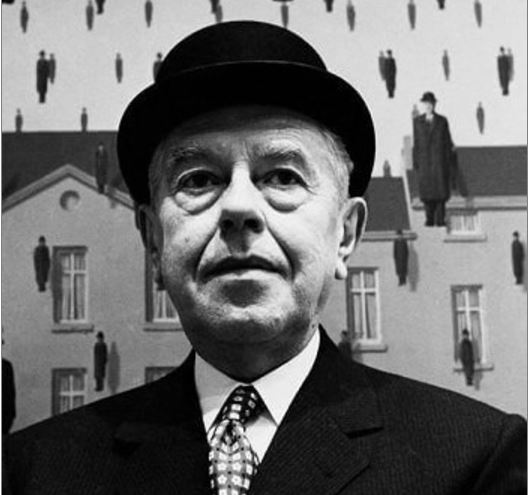René Magritte, the Belgian painter celebrated for his imaginative and thought-provoking surrealist art, has cemented his place among the most valuable artists in history. On Tuesday night at Christie’s in Manhattan, one of Magritte’s masterpieces, The Empire of Light (L’Empire des Lumières), was sold for $121.2 million with fees, a record for the artist. This landmark sale marks Magritte’s entry into the elite $100 million club of artists whose work has achieved such extraordinary valuation.
René Magritte described his paintings saying, “My painting is visible images which conceal nothing; they evoke mystery and, indeed, when one sees one of my pictures, one asks oneself this simple question, ‘What does that mean?’ It does not mean anything, because mystery means nothing, it is unknowable.”
The legendry heavyweights, whose paintings sold for more than $100 million at no fewer than six auctions, include Francis Bacon, Leonardo da Vinci, Gustav Klimt, Amedeo Modigliani, Andy Warhol, Jean-Michel Basquiat, and Pablo Picasso. Shockingly till date, no living artist has achieved this price level at auction.
René Magritte: A Surreal Legacy
René Magritte was born in Lessines, in the province of Hainaut in Belgium, in 1898. He was the oldest son of Léopold Magritte, a tailor and textile merchant, and Régina. René Magritte (1898–1967) is synonymous with surrealism, the art movement that sought to challenge reality and delve into the unconscious mind. With his distinct style, Magritte presented ordinary objects in unexpected juxtapositions, evoking mystery and inviting deep reflection. Works like The Son of Man (the man in a bowler hat with a green apple obscuring his face) and Ceci n’est pas une pipe (This is not a pipe) remain iconic symbols of the movement.
However, The Empire of Light stands as one of Magritte’s most enigmatic and celebrated series. Depicting a street scene cloaked in twilight with a paradoxical daytime sky above, the painting defies natural laws, creating a dreamlike tension. Its haunting beauty resonates universally, captivating art lovers and collectors alike.
The Record-Breaking Sale
At Christie’s auction in New York, the spotlight turned to The Empire of Light, one of Magritte’s most ambitious explorations of light and shadow. A bidding war ensued, driving the final price to over $100 million, including fees. This sale shattered Magritte’s previous record of $79 million, set in 2022 by another painting from the same series.
This remarkable price reflects the increasing value of surrealist art in the global market. Collectors are drawn to Magritte’s ability to merge philosophical depth with visual simplicity, making his works timeless.
Surrealism’s Enduring Appeal
The record-breaking sale also underscores the enduring allure of surrealism. In a world saturated with chaos and ambiguity, Magritte’s art offers viewers an imaginative escape while challenging them to question their perceptions.
Magritte’s entry into the $100 million club aligns him with other luminaries like Picasso, Van Gogh, and Monet, whose works have transcended cultural and historical boundaries. This milestone not only reaffirms his genius but also elevates surrealism’s position in art history.
The Young Girl Eating a Bird is the most gruesome painting Magritte ever did. It’s a companion piece to The Murderous Sky (immediately below) depicting four identical bloody dying birds flying in front of a mountain of rocks. It is said that this painting might be scripted (based) on a poem “The Girl Who Ate Birds” by Paul Nouge which was written about at the same in 1927 (published in 1956). It’s possible that the poem could also be based on the painting.

René Magritte was born in 1898 to a wealthy manufacturer. In 1912, his mother was found drowned in the River Sambre, having died by suicide, which brought public humiliation to the family. From 1916 to 1918, René studied at the Académie des Beaux-Arts in Brussels; however, he left the school, believing it to be a waste of time. His later paintings reflect the influence of Cubism, a movement popularized by Pablo Picasso at the time. In 1922, he married Georgette and took on various small jobs, including painting cabbage roses for a wallpaper company, to help pay the bills.
Magritte’s achievement is a proud moment for Belgium, the country of his birth. The artist’s works have long been celebrated as national treasures, and this sale serves as a testament to his global influence. The Magritte Museum in Brussels continues to attract thousands of visitors annually, further solidifying his legacy.
René Magritte’s induction into the $100 million club is a landmark moment in the art world. The Empire of Light has not only broken records but also illuminated the timeless appeal of surrealism and Magritte’s unparalleled ability to bridge the ordinary and the extraordinary. In The Empire of Light, Magritte masterfully contrasts a nocturnal street scene with a daytime sky, creating a hauntingly beautiful exploration of light, shadow, and perception. His art challenges viewers to look beyond the surface, merging logic with the illogical in ways that feel both unsettling and fascinating.
This sale is a reminder of the transformative power of art—a surreal journey that invites us to question the boundaries of reality and imagination. René Magritte, once again, stands as a master of that journey. Magritte’s influence extends beyond fine art, impacting popular culture, advertising, and even philosophy. His ability to provoke thought through simplicity has made his work timeless. As a surrealist, Magritte did not aim to provide answers but to stimulate curiosity and wonder. His art remains a reminder that reality is not always as it seems, and the ordinary can be extraordinary when viewed through the lens of imagination.

